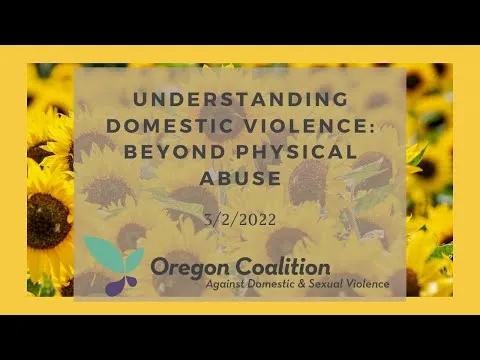
Supporting Victims of Domestic Violence - free online course at futurelearncom 
Learn how to support victims of domestic violence with this free online course from The University of Sheffield. Gain valuable knowledge on spotting the signs of domestic violence and offering support to those affected. Explore topics such as gender roles, different forms of abuse, the global prevalence of domestic violence, and the impact on victims and their families. Discover how to recognize signs and symptoms, engage in effective communication, and create safety plans. Understand the legal protections available and learn about working in multi-agency partnerships. Sign up now and make a difference in the lives of domestic violence victims. ▼
ADVERTISEMENT
Course Feature
![]() Cost:
Cost:
Free
![]() Provider:
Provider:
Youtube
![]() Certificate:
Certificate:
No Information
![]() Language:
Language:
English
![]() Start Date:
Start Date:
2019-11-30 00:00:00
Course Overview
❗The content presented here is sourced directly from Youtube platform. For comprehensive course details, including enrollment information, simply click on the 'Go to class' link on our website.
Updated in [September 27th, 2023]
We considered the value of this course from many aspects, and finally summarized it for you from two aspects: skills and knowledge, and the people who benefit from it: (Please note that our content is optimized through artificial intelligence tools and carefully reviewed by our editorial staff.) What skills and knowledge will you acquire during this course? During this course, learners will acquire the following skills and knowledge: 1. Understanding gender and gender role expectations: Learners will explore the concept of gender and how societal expectations can contribute to domestic violence. 2. Identifying forms of domestic violence and abuse (DVA): Learners will learn about the different types of domestic violence and abuse, including physical, emotional, and financial abuse. 3. Recognizing the prevalence of DVA around the world: Learners will gain an understanding of the global scope of domestic violence and its impact on individuals and communities. 4. Understanding factors that influence violence: Learners will explore the various factors that contribute to domestic violence, such as power dynamics, cultural norms, and social inequalities. 5. Understanding the impact on victims, families, and children: Learners will learn about the physical, emotional, and psychological effects of domestic violence on victims, as well as its impact on families and children. 6. Recognizing signs and symptoms of DVA: Learners will develop the skills to identify the signs and symptoms of domestic violence, enabling them to offer support and assistance to victims. 7. Effective communication with victims: Learners will learn how to communicate sensitively and effectively with victims of domestic violence, providing them with the support they need. 8. Safety planning: Learners will acquire knowledge on how to help victims create safety plans to protect themselves and their children from further harm. 9. Understanding how the law can protect victims: Learners will gain an understanding of the legal frameworks and protections available to victims of domestic violence. 10. Working in multi-agency partnerships: Learners will explore the importance of collaboration and partnership working in supporting victims of domestic violence, including the roles of different agencies and organizations. By completing this course, learners will be equipped with the necessary skills and knowledge to effectively support victims of domestic violence and contribute to efforts in preventing and addressing this issue. Who will benefit from this course? This course will benefit individuals who are interested in or work in professions related to supporting victims of domestic violence. This includes professionals in the fields of social work, counseling, law enforcement, healthcare, and education. It will also be beneficial for individuals who work in community organizations or advocacy groups focused on domestic violence. The course covers a wide range of topics including gender and gender role expectations, different forms of domestic violence and abuse, the prevalence of domestic violence around the world, factors that influence violence, the impact on victims and their families, recognizing signs and symptoms of domestic violence, talking to victims, safety planning, how the law can protect victims, and working in multi-agency partnerships.
Course Provider

Provider Youtube's Stats at AZClass
Discussion and Reviews
0.0 (Based on 0 reviews)
Explore Similar Online Courses

Five key benefits of Focus Mastery Consulting

LIVE Praxis Elementary Education 5001 Webinar - Recorded on 04&22&2023 Kathleen Jasper
![5 Essential Strategies for Your Domestic Violence Defense [2023]](/ccsimg/dcs/img_tools/6751888ccbfc28bd5970424465417fdd.webp)
5 Essential Strategies for Your Domestic Violence Defense [2023]

Domestic Violence Safety Planning training

Coercive Control as Intimate Partner&Domestic Abuse: Understanding the Harm Advocating for Change

WEBINAR: Children Caught in Invisible Chains: Coercive Control Domestic Abuse & Children

Understanding Domestic Violence: Beyond Physical Abuse (Part 1 of 4)

52 - Week Domestic Violence Prevention Classes

Domestic Violence Training 2020

Introduction to Domestic Violence - Online Course
![When Domestic Violence Goes Digital [Webinar]](/ccsimg/dcs/img_tools/7acd60f2bda4c66a569e3deb43349f94.webp)

Start your review of Supporting Victims of Domestic Violence - free online course at futurelearncom